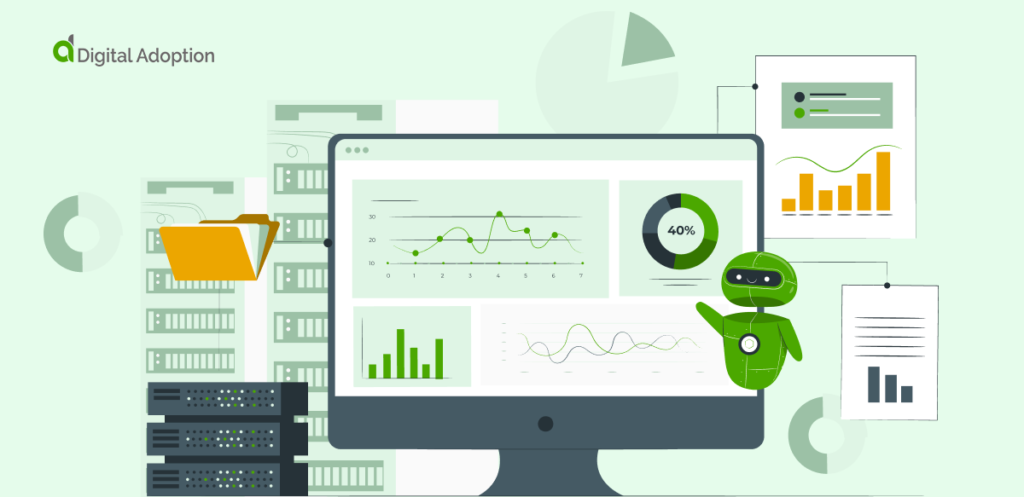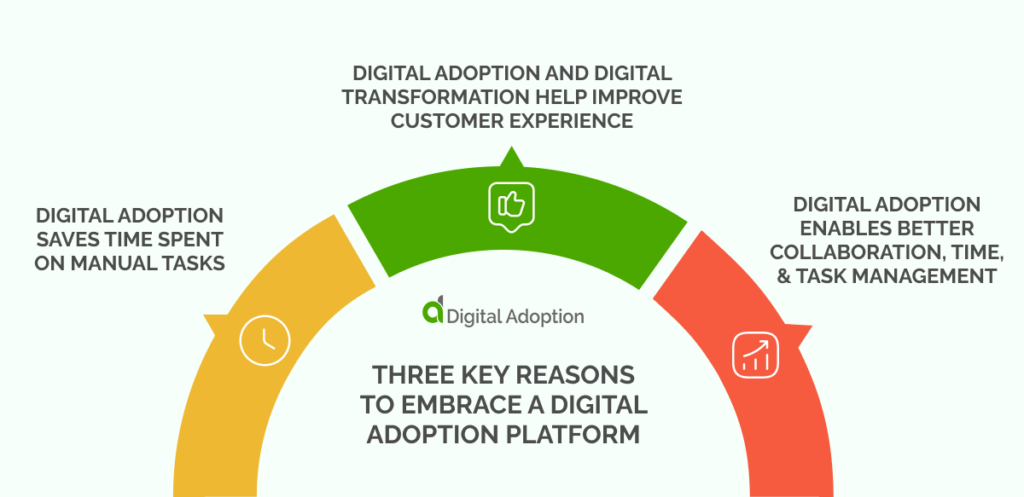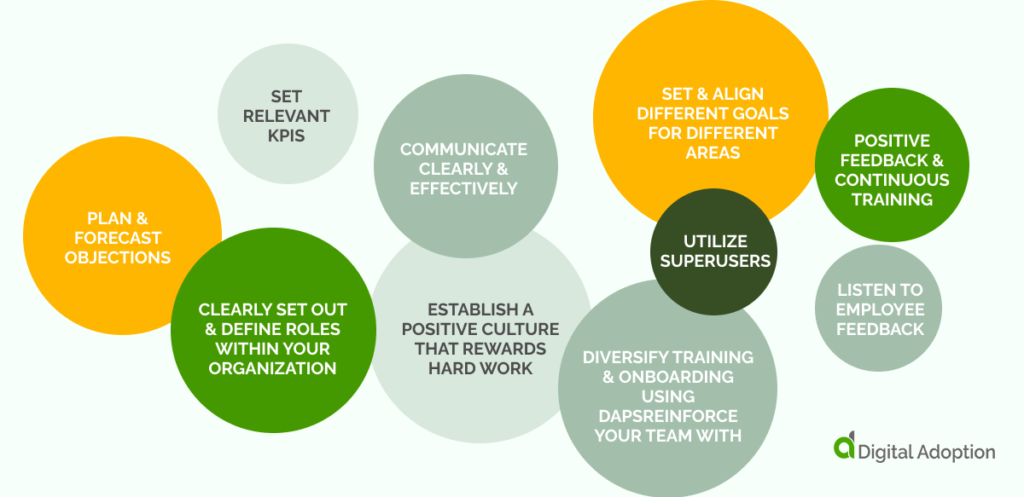Why is everyone talking about digital adoption these days? How is digital adoption relevant to today’s rapidly changing market? And how can companies ensure they are getting the best out of their digital adoption strategy?
We can answer all these questions in detail by looking at digital adoption and describing the benefits and the importance of a firm plan and challenges to success. But first, let’s clarify something. What exactly is meant by digital adoption?
What Is Digital Adoption?

Digital adoption refers to new technology increasing business performance. Most successfully achieved digital adoption platforms involve meticulous planning to drive digital adoption, often continuous training materials utilized by CIOs, and a positive change management culture.
Why Is Digital Adoption Important?
Digital adoption platforms involve more than simply using new or existing digital tools differently. A digital adoption process is a philosophy, an approach to the digital company led from the digital workplace.
Above all else, this philosophy is essential because of the benefits of digital adoption. A digital adoption strategy involves an agile, flexible approach that is not just open to change but proactively seeks the potential for changes at all times. This flexible, agile approach has many benefits, including constructively dealing with technology and market disruption. Many businesses use this approach to ensure successful digital adoption.
Three Key Reasons To Embrace A Digital Adoption Platform

There are many benefits to the digital adoption process, such as learning new skills, keeping team members agile and stimulated, boosting productivity, and improving employee experience overall. However, in the next section, we will focus on the three main reasons to embrace digital adoption. The first of these is time-saving.
- Digital Adoption Saves Time Spent on Manual Tasks
One of the most significant constraints a company faces is time. Technology within a successful technology adoption takes on the manual aspects of the workloads.
These efficiency savings can take the form of AI-powered chatbots taking customer queries, automated scheduling, and security software adoption challenges can be met through software applications from companies such as Cisco, Symantec, and CrowdStrike.
Time savings lead to increased profits and more valued and empowered team members as they take on more vital, specialized tasks previously beyond the reach of technology. In these ways, digital adoption can save time on manual tasks once completed by team members.
- Digital Adoption And Digital Transformation Help Improve Customer Experience
It’s not just employee experience that a digital adoption platform can improve, but, crucially, the experience of customers. Following the implementation of a new system for digital adoption, the experience is more personalized, enabling people to use new processes to the fullest extent.
Using new technology is not only an essential part of digital adoption to drive innovation for the benefit of a company. New technology also allows customers to be excited and stimulated as the company offering them a service remains in line with the currently available technology, some of which some customers will not have used before.
Virtual Reality (VR) and Augmented Reality (AR) show how the customer experience can become more interactive and engaging through technology. Offering customers the opportunity to use web-based applications like the Google Lens app to manipulate an object and look at it in 3D may make them more likely to understand the product and lead to a purchase.
- Digital Adoption Enables Better Collaboration, Time, & Task Management
When it comes to collaboration, more meetings do not mean better productivity. Understanding the importance of cooperation and concentrating on quality, not quantity, is achieved by new technology. Who is the best person or group with whom to collaborate? How much time is needed? Are we using the best technology to implement this collaboration?
Collaboration within any digital transformation or adoption strategy requires these questions. With these questions in mind, the partnership is beneficial. Establish whether a meeting is necessary, with whom, and with what technology. Technology’s judicious use can also remedy the Zoom burnout many team members have reported.
How Does Digital Adoption Lead To Better ROI?

Technology requires an initial investment for purchase and maintenance during use but lacks the complexity of humans carrying out tasks. Depending on management, human team members can impact Return On Investment (ROI) positively or negatively. During Covid-19, most companies cut spending on human recruitment but increased digital adoption spending.
On the other hand, technology use such as combining marketing technologies to extend capabilities is an example of working smarter, not harder, when it comes to improving ROI. Improvements in ROI implement existing technology differently to expand the initial investment. Linking existing technologies together rather than investing in new technologies is a way of achieving this at the organizational level.
The Importance Of Creating A Digital Adoption Framework

First, there is a plan to implement a digital adoption framework. Goals are at the center of this plan, as they allow checking in at certain times to check progress and ensure the organization is heading in the right direction.
Set & Align Different Goals For Different Areas
One of the significant digital adoption challenges within any digital transformation is goal-setting. Goal allocation is essential for all the benefits of new digital technology, leading to specialized goals for departments and teams.
Assigning any goal to monitor the success of a new piece of software designed to automate scheduling programs will not feel relevant to a design department. Likewise, setting a goal of training for new design software applications is ineffective when allocated to an administrative department.
Goal setting must be at the forefront of any digital transformation investment, particularly for a large enterprise with many departments. Only then can successful adoption take place.
Set Relevant KPIs
Key Performance Indicators (KPI) are at the core of metrics that drive digital adoption for any business. New tools and technologies, such as software and other tools, are implemented as part of a digital adoption plan to improve KPIs. But how can this be assured through planning and implementation?
KPIs must be relevant to the digital adoption plan at all times. There are four simple success measures to follow.
- Intention
What is the intended use, potential needs to fulfill, and problems to solve using the new technology?
One example is a new piece of software designed to reduce the time taken for team members to answer basic customer queries. The team members address complex queries. The time taken by the team to complete these tasks before and after the new software will measure the new software’s success as a KPI.
- Features
If customers do not know the features of new technology, they cannot use them. Surveys can measure the success of features, such as a new feature of an existing app.
- Satisfaction
Satisfaction is all about User experience (UX). User onboarding is part of this, as users need to feel satisfied that they are in the right hands straight from the get-go. Any new processes need to be explained to customers entirely for user satisfaction.
Survey Data Informs KPIs:
- The overall experience of customers
- Completion rate of the intended task
- % of customers likely to return
- % of customers likely to recommend
- Outcomes
Outcomes for any digital adoption platform are KPIs showing improved human performance. Team members work more efficiently, improve their output, and provide an enhanced customer experience (CX). KPIs take the form of improved staff and customer experience ratings.
Clearly Set Out & Define Roles Within Your Organization
Roles are clearly defined to facilitate a successful digital adoption strategy roll-out. The CEO or CIO may assign new responsibilities to present employees alongside existing roles. An administrative department team leader may be allocated the role of Digital Adoption Lead For KPIs in the administrative department as a way of recording digital adoption outcomes, for example.
Roles to oversee all departments can be essential to meet organizational goals. New employees of senior ranking and experience can take on positions such as an overall Digital Adoption Lead and Adoption Platform Lead. The Digital Adoption Lead role coordinates the digital adoption strategy and is the point of reference for staff. This individual has excellent public speaking and leadership skills.
The Adoption Platform Lead is more technical, focusing on maintaining the technology used to deliver digital adoption. Outstanding communication skills are required, as this role includes answering questions about the more technical sides of digital adoption. The Adoption Platform Lead has extensive experience setting up and maintaining digital adoption solutions.
A third optional role is a Digital Transformation Lead. This role ensures everyone knows the benefits of digital adoption as a means to digital transformation. The person filling this role is responsible for using their senior level of experience to assist the Digital Adoption Lead in sorting out more complex staffing issues with the digital adoption roll-out.
Hesitancy to adopt new technology, a perceived lack of time and resources by staff and an outright resistance to technological or cultural change are some of the many problems faced as part of a digital adoption strategy. The Digital Transformation Lead will need extensive experience to tackle these issues. A Digital Transformation Lead has excellent skills in change management.
These three roles work together in building employee training for all team members. The training follows a dialogue with staff to fit their needs. A CEO must move to act quickly in establishing these roles in advance of a proposed digital adoption strategy, as lack of leadership on digital adoption and poor training will doom a strategy straight from the start.
However, with these three roles established early on and the individuals given time to liaise with staff and form trusting relationships, they will enhance and ensure the success of any digital adoption strategy.
Communicate Clearly & Effectively
For any digital adoption strategy, team members are essential. Without team members, there is nobody to adopt the digital processes using digital technologies. For the strategy to be successful, communication is the key to unlocking the potential of team members. The basis of this communication comprises several aspects.
Again, like training, communication needs to be geared toward the needs of the team members on the receiving end. Considerations could be whether team members are native speakers of a language or have cultural, mental health, or disability needs. Age can also impact communication, as team members may be more or less familiar with emojis and social media. Although social media is an effective tool for business and relationships, some older team members may need support in adopting and feeling confident with such technologies.
Knowing these needs is essential for every team member, especially those in more senior roles. For the three new roles described in the ‘Clearly Set Roles‘ section above, knowing needs is paramount to achieving success in communication by meeting these individual needs to establish trust and successful professional relationships, ensuring successful digital adoption.
Utilize Superusers
First of all, what are superusers? The ‘superusers’ term is a lot simpler than it sounds, as superusers are specialized IT administrators of a network.
The role of the superuser is to oversee and coordinate networks, ensuring smooth running and optimal efficiency. This role may sound a little boring to some, but it is integral within the internal processes of any size organization. The superuser role is particularly essential to running enterprise applications, as these require vast amounts of administrative labor due to many users.
If an existing superuser becomes over-encumbered due to the introduction of digital adoption, more superusers must be trained. Lastly, multiple superusers may be needed for a large company to specialize in its department adequately.
Establish A Positive Culture That Rewards Hard Work
Culture. This factor is the one most significant obstacle to successful digital adoption. Its significance in the success of any digital adoption platform, strategy, or implementation cannot be understated. It will be guaranteed to fail with all the highly skilled, trained senior management working in a culture not ready for digital adoption. So how do we change a culture resistant to change?
There are many ways, such as hiring a Change Management Lead and other contact points for team members to ask about what changes are happening and why. Such lines of communication are imperative to digital adoption success.
Another way is to praise and reward the hard work of team members who focus their efforts on using the digital adoption platform in all they do. This act then establishes baseline role models for other team members to emulate. Holidays or other gifts can be given, for example.
Another method is to create a little healthy competition by setting up goals for digital adoption and rewarding these with specific gifts. For a team member who didn’t know what digital adoption was a year before, to successfully apply to a junior digital adoption role a year later, a reward would show how any team member can adopt the digital strategy, despite initial lack of knowledge or hesitation. How much a staff member has learned, especially if they had no prior knowledge of a topic, can also be the basis for a reward.
Plan & Forecast Objections
On the other side of good contributors to a digital adoption culture comes the negative contributors. These are rarely ‘bad apples’ who want to complicate things and are stubborn. More frequently, any objections to digital adoption come from a lack of knowledge and understanding about how a strategy can support team members and customers to increase productivity, output, and profits, benefiting everyone.
Four frequent objections come up during digital adoption strategies:
- Team members resisting technological change
- Onboarding for a digital adoption platform is inadequate.
- Training for new tools at a large scale is complex and challenging.
- Calculating user adoption is complex and difficult.
Senior transformation and digital adoption team members complete forecasting of objections. A combination of experience of the previous transformation and digital adoption strategies and knowledge of current team members help to forecast objections.
More than anything else, communication is needed. Team members need to feel involved in decision-making regarding digital tools and digital processes before, during, and after digital adoption. Even if involvement is for small decisions, team members value being asked their views and will engage better if involved.
Diversify Training & Onboarding Using DAPs
Introducing several new digital technologies, such as new software, into an organization at once can be overwhelming for team members. However, this is often necessary for a digital adoption to succeed in a given time frame. Digital Adoption Platforms (DAP) exist for this reason.
DAPs are suites of software in which helpful hints and tips explaining how to use the software’s more advanced features work on top of the functional software (the program that does a specific job). Some DAPs even contain tools to record and measure data such as sales figures and user behavior.
DAPs are infinitely valuable for team members to become confident with advanced features of new software and for reducing some of the administrative time of explaining the purpose and characteristics of new software involved in digital adoption.
Reinforce Your Team With Positive Feedback & Continuous Training
A digital adoption strategy is an ongoing process, as are the processes within it. This process includes motivation for staff using positive reinforcement, sometimes having to explain the same thing in different ways (more than once!), and, most importantly, continuous training.
The way companies function today can be exciting but also grueling. The narratives on technology, change, and disruption is ongoing, and the demands these constant changes place on staff can be overwhelming. Training can bridge the gap between current knowledge and overwhelm and readiness and confidence to meet whatever challenge the market can throw at team members.
Listen To Employee Feedback
Communication is of the utmost importance when it comes to digital adoption. It may feel like this point is becoming a little belabored, but it often gets missed. Employees need to have three tools to see that senior colleagues are listening. The first of these processes for team member feedback is access.
- Access
Team members have a means of communicating their thoughts about digital adoption. Along with this comes a culture of openness to receiving feedback without being made to feel the staff member’s ideas are unnecessary.
HR departments can ensure access points are well advertised and promote a culture of openness.
- Action
Processes are in place to ensure actions happen as quickly as possible to provide an agile, reliable dialogue channel.
- Follow up
Team members must be able to see the follow-up happening. A process exists where staff can see the outcome of their feedback. This process empowers staff to give feedback in a safe, dynamic environment and reduces resistance to change.
Such processes ensure that staff cannot only express their thoughts meaningfully but that the senior digital adoption team can understand the reasons for staff resistance to digital change more fully. In this way, employee satisfaction is improved, with a knock-on effect for higher productivity and incentives for engagement with the new technologies of digital adoption.
How To Ensure Digital Adoption Success?

Digital adoption involves many aspects. From ensuring the right roles to creating a change-positive culture in which all team members feel listened to, digital adoption can be time-consuming, making it difficult to measure success. So how can a company ensure everything is in place for digital adoption to be successful?
The short answer to this is communication. When communication channels are open, team members communicate concerns, worries, and obstacles to fulfilling their role within a digital adoption solution. Actions and adjustments occur from these concerns. Usage of the software is optimal, and attitudes are positive toward adoption within an adoption-positive culture.
As a result, users achieve digital adoption and will feel the benefits, increasing a company’s profile against competitors. Complete digital adoption is then performed as part of the unavoidable digital adoption revolution as new digital processes are used by customers and staff consistently.
Widespread digital adoption refers to customers and team members, so both need to be included within any digital adoption plan. Access, Action, and Follow-up is a valuable framework for ensuring views are collected and actioned. Buy-in occurs when staff and customers are correctly onboarded and feel listened to and their feelings actioned.
Putting people at the core increases productivity, profits, and agility and protects against future disruption. The other aspects of digital adoption, such as the new technology, software, and new digital processes, will all come to fruition when the focus is on people. This success is because those utilizing them will use them to their full potential, and adoption will occur as quickly and effectively as possible.















